Call Us:+975-17885658
Email Us:info@dheywangbhutan.btdheywangbhutan@gmail.com
Photoraphy Tour
About Photo Tour
We arrange special Photo Tour like landscape photograph, Festival photograph, market, Ceremonies with special photograph guide. Bhutan festival dedicated to enriching your life, helping you see the world with new eyes, and creating images that express your unique experience to others. The Photo Tour Collection is a leader in the field of wildlife and landscape photography tours; clients attest to this by traveling with us year after year.
Photographic Leaders
The Photo Tour Collection is comprised of working professionals, photographers with years of photographic education and leader experience. You’ll be impressed with their credentials, but moreover, you will enjoy traveling with them in the field. They are dedicated and eager to make your experience memorable and productive. They are there, first and foremost, to provide experience, assistance, and enrichment during your photographic journey. Each tour leader is listed with biographical information, leadership style, and web site link below. Feel free to e-mail them with specific questions that you might have. Amazing trips for photography lovers.
Join a small group on a travel program designed by and for photographers. The pace of our trips is carefully planned, and locations have been well researched and scouted. From years of experience, we know the seasonal movement of wildlife, great landscapes, and villages where we can meet the people of Bhutan.
Details/Best Months |
March/April/May/August/September
October and November |
| START | Paro |
| FINISH | Punakha |
| DESTINATIONS | Paro-Thimphu-Trongsa-Bumthang-Phobjikha |
| DEPARTURE/RETURN LOCATION | Paro International Airport |
| DEPARTURE TIME | Please arrive at least 2 hours before the flight. |
| WHAT’S INCLUDE |
|
| WHAT’S EXCLUDED |
|
Best Season
Spring (March to May) and autumn (September and October) are the best time for touring and trekking in Bhutan. The months of April and May offer the natural grandeur of rhododendron blooms whereas Bhutan observes its biggest festivals during spring.
Trip Start Dates
We will organize this trip on the dates requested by you. Please Contact Us for your customized departure date.
Additional Information
Our website contains as much information as possible about this trip. However, if you wish to discuss any aspect of this trip or your suitability for it please contact us.
HIGHLIGHTS OF THEÂ THE BHUTAN PHOTOGRAPHY TOUR
Bhutan provides a stunning array of photographic opportunities, pristine landscapes, sacred and ancient sites, colourful festivals and a fascinating people. This Ultimate Bhutan Photography Tour visits the many cultural and wilderness highlights of the western valleys of Paro, Thimphu, Punakha and the central areas of Trongsa and Bumthang.
- Photograph the colourful rituals and dances of the spectacular Thimphu Tsechu.
- Experience the intimate Tangbi Mani Festival located near Bhutan’s spiritual heartland, Bumthang.
- Explore Bhutan’s central valleys, rich with ancient historical and sacred Buddhist sites.
- Discover some of the most sacred Buddhist monasteries and temples in the Himalaya.
- Encounter Bhutan’s unique culture up-close with farmhouse visits and village excursions.
- Drive over high mountain passes affording sensational views of the Himalayan peaks.
- Visit many cultural attractions including medieval fortresses (Dzongs), markets and museums.
- Hike up to the famous Taktsang Monastery, perched on a cliff 900m above the valley floor.
- Marvel at the elaborate and ancient wall paintings and carvings in Dzongs and temples.
- Traverse beautiful landscapes from lush valleys to dense forests.
- Incorporate a Value-Added Option such as a cooking lesson or meditation session with a monk.
Note: This itinerary is a sample itinerary to give you a general idea of the likely trip schedule. We have designed this itinerary including the best cultural and natural aspects of this country. We can further customize the itinerary to suit your specific interest and needs. Please Talk to Us for more details. Itinerary is subject to flight and hotel availability.
Outline Itinerary
14 Days
DAY 01: ARRIVE PARO THIMPHU
DAY 02: THIMPHU (ATTEND THIMPHU TSECHU)
DAY 03: THIMPHU (ATTEND THIMPHU TSECHU)
DAY 04: THIMPHU PUNAKHA
DAY 05: PUNAKHA
DAY 06: PUNAKHA TRONGSA
DAY 07: TRONGSA BUMTHANG
DAY 08: BUMTHANG (ATTEND TANGBI MANI)
DAY 09: BUMTHANG
DAY 10: BUMTHANG PHOBJIKA VALLEY
DAY 11: PHOBJIKA VALLEY THIMPHU
DAY 12: THIMPHU PARO
DAY 13: PARO
DAY 14: DEPART PARO
Not really satisfied with this itinerary ? Make your own Customize It!
Day 1
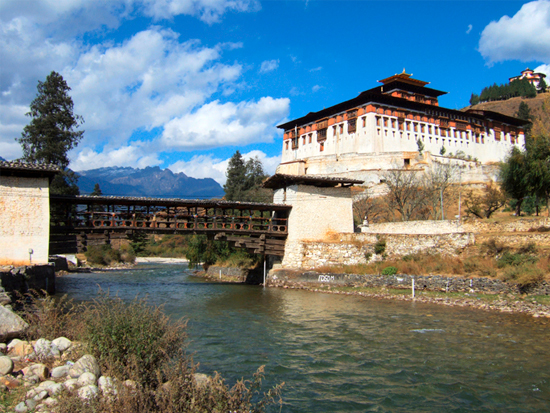
Arrive Paro Thimphu
The flight to Paro is one of the most spectacular mountain flights in the world, with a constantly changing panorama of some of the highest mountains on earth. Our Login Bhutan representative will meet you at Paro airport exit doors following customs formalities.
After lunch enjoy afternoon sightseeing around Paro, including a visit to the Ta Dzong Museum housing many religious relics, works of art and handicrafts offering a great orientation into Bhutan’s historical, cultural, and religious past. Next, visit the Rimpong Dzong to see the painting of the great saint Milarepa, considered as the master of meditation by the Bhutanese and believed to have attained enlightenment in a lifetime. Dzong’s are large monasteries and district administrative centres, which were once strategic forts. Afterwards, drive to the capital, Thimphu (1.5 hours) following the Pachu River. Before dinner at the hotel there will be an orientation on Bhutanese etiquette by your guide. Overnight at your hotel in Thimphu.
Day 2
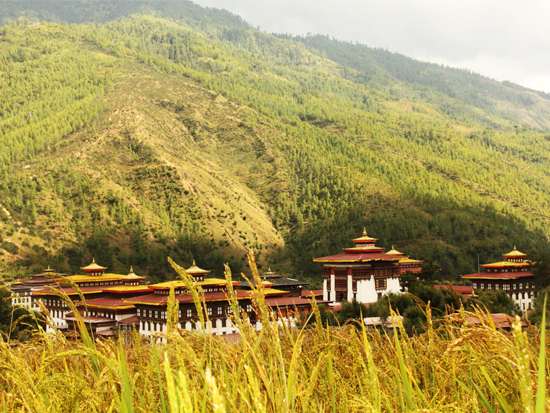
Thimphu
After breakfast, drive to Tashichhodzong to attend the Thimphu festival. You will see locals dressed in their finest clothes who have walked from miles around to attend the festivities. They come to watch masked dances, to pray, and to feast. While the underlying purpose of the festival is spiritual, dances are more often like plays, telling stories where good triumphs over evil, or depicting significant historical events, especially surrounding the life of Bhutan’s patron saint, Padmasambhava (also known as Guru Rinpoche). There is inevitably a great deal of socialising as well.
Tashichhodzong, the fortress of the glorious religion. Initially erected in 1641 by Shabdrung Ngawang Namgyal, it was rebuilt in the 1960s during the reign of Bhutan’s third king in the traditional style, without plans or nails. Tashichhodzong houses some ministries, His Majesty’s secretariat, and the central monk body. Overnight at your hotel in Thimphu.
Day 3

Thimphu
Enjoy a morning of sightseeing, including a visit to 12th century Changangkha Temple, the Zilukha Nunnery and the National Memorial Chorten depicting the Buddhist faith in the form of paintings and statues. This temple was first initiated by the Third King as a protection from the negative elements of modernisation, and as a monument to world peace. The Royal Queen Mother completed it as a memorial stupa for the Third King who passed away in 1972.
In the afternoon return to Tashichhodzong to further experience the colourful events of the Thimphu festival. Overnight at your hotel in Thimphu.
Day 4
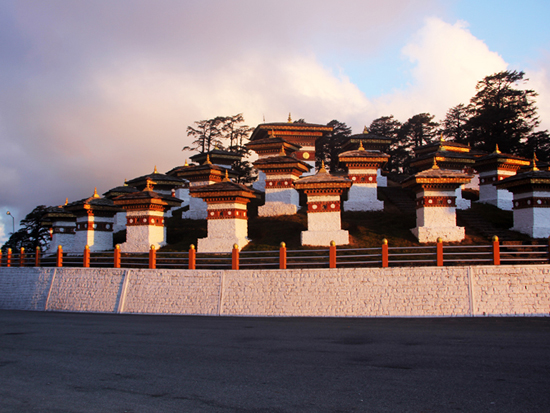
Thimphu-Punakha
Drive over the Dochu-La pass (3,100 meters), which on a clear day offers an incredible view of Himalayan peaks before descending into balmy Punakha valley (about 3 hrs total driving time). The drive through the countryside affords a glimpse of everyday life in this most remote of Himalayan kingdoms. In the Dochu-La area there are vast Rhododendron forests that grow to tree size and bloom in late April/early May covering the mountains in a riot of glorious spring colour.
Punakha was the ancient capital of Bhutan. On arrival, visit Punakha Dzong, the Palace of Great Happiness built in 1637 by the Shabdrung, the Unifier of Bhutan. It is situated at the confluence of the Mo Chu and Pho Chu (Mother and Father Rivers) and is the winter headquarters of the Je Khenpo and hundreds of monks who move en masse from Thimphu to this warmer location. The three story main temple of the Punakha Dzong is a breathtaking example of traditional architecture with four intricately embossed entrance pillars crafted from cypress and decorated in gold and silver. The inside walls are covered with elaborate murals depicting the teaching of the Buddha. It was here in 1907 that Bhutan’s first king was crowned.
Day 5
Bumthang
In the morning visit Kurjey Lhakhang, one of the most sacred places in the kingdom where Bhutan’s patron saint Guru Rimpoche meditated and 7th century Jambay Lhakhang. It dates back to the origins of Buddhism in Bhutan and is one of the Kingdoms oldest temples.
After lunch continue sightseeing including Jakar Dzong and Tamshing Lhakhang, founded in 1501 by Pemalingpa and containing interesting and ancient Buddhist wall paintings. Overnight in Bumthang.
Day 6
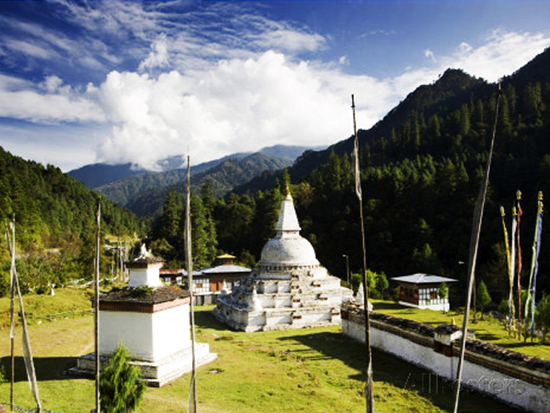
Punakha-Trongsa
Transfer to Trongsa (6 hrs). Drive via the bustling market town of Wangduephodrang. Drive up a winding mountain road through oak and rhododendron forests and over the Pele La pass (3,420m) on the Black Mountain range towards Trongsa. This pass is traditionally considered the boundary between western and central Bhutan. Further down the road stop to visit beautiful Chendebji Chorten. It is built in a style unusual for Bhutan, with painted eyes facing the four directions. The imposing Trongsa Dzong can be viewed across a deep canyon to signal your approach to the town around a curving road.
On arrival, enjoy some relaxation time before visiting Trongsa Dzong, a masterpiece of Bhutanese architecture. Trongsa is the largest Dzong in Bhutan. The foundations of Trongsa Dzong were laid in the 16th Century and there are now 22 temples in the complex. The view from the Dzong is spectacular and one can see across the impressive landscape for many miles. In the old days, it was the vigilance point for both the eastern and western trade routes, thus a strategically important Dzong. Overnight at your hotel in Trongsa.
Day 7
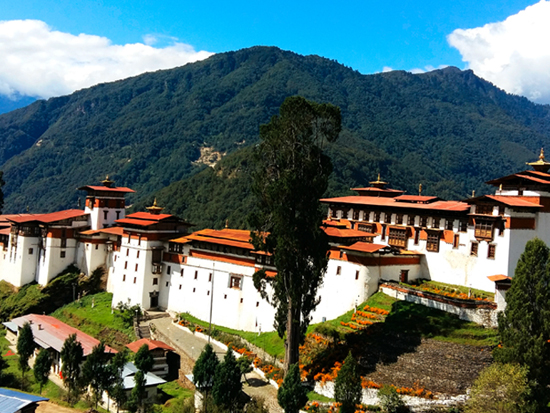
Trongsa-Bumthang
Following breakfast visit the Ta Dzong museum located on the hill overlooking the Trongsa Dzong. The museums main focus is on the history of the monarchy, and is dedicated to the coronation and centenary celebrations of the Bhutanese monarchy with very rare and precious artefacts on display. These include statues built in the 17th century, to the first King’s Namza (dress), the Raven Crown and Sword of Trongsa Penlop Jigme Namgyal and the 3rd King.
Afterwards, proceed to Bumthang (2.5 hrs), one the most spectacular valleys in Bhutan and also the spiritual and historical heartland of the country. The road winds steeply up to Yo Yutung La Pass (3,400m) before descending down through dense coniferous forest to Chummey valley. From here it is about an hour to Jakar, Bumthang’s main township.
Bumthang is home to some of Bhutan’s oldest Palaces, Buddhist temples and monasteries. The valley’s barley fields, apple groves and meadows lay below huge hills which climb up towards the Himalayan mountain wall separating Bhutan from Tibet. The beautiful architecture unique to Bhutan is evident in the many large farmhouses and temples. Bumthang is associated with Guru Rimpoche (Padmasambhava) and with Terton Pemalingpa.
After lunch, visit Jakar Dzong, also known as Fortress of the White Bird. It was founded by the great grandfather of Shabdrung. The Dzong was initially built as a Monastery in 1549 but was upgraded after Shabdrung had firmly established his power in 1646. The Dzong is now used as the administration center for Bumthang valley.
Day 8
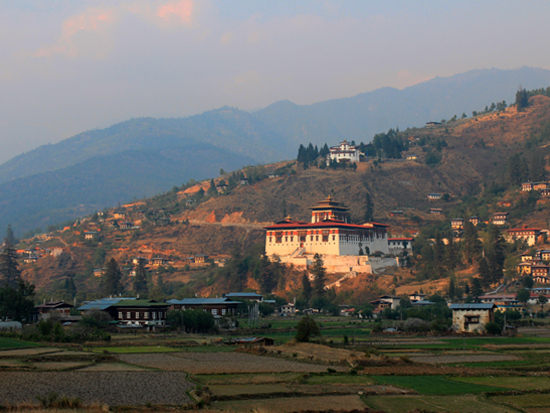
Bumthang (Attend Tangbi Mani)
Transfer to the remote Tangbi Mani village for the day by vehicle and a 45 minute walk. Spend the day viewing the Tangbi Mani Festival in an enchanting rural atmosphere. You will be captivated by the dances and costumed performances accompanied by clapping cymbals, drums, horn and the unforgettable chanting of Buddhist monks. Watch on as the dancers whirl their array of colourful brocades through the air, play local games and stroll handicraft stalls, explore around the village and visit locals at their homes. In the afternoon transfer back to Jakar. Overnight at your hotel in Bumthang.
Day 9
Bumthang
Enjoy a day of sightseeing in Bumthang beginning with Jampey Lhakhang, one of 108 temples built by the Tibetan King Songtsen in the 7th Century. It was here that Guru Rimpoche conducted his first sermon on Tantric Buddhism for his host King Sendha, the local ruler, his family and subjects. Continue on to Kurjey Lhakhang, famous for a rock within one of the temples that features a body imprint of the great master Guru Rimpoche. The big cypress tree in the temple grounds is believed to be the walking stick of Guru Rimpoche.
Afterwards visit Tamshing Lhakhang, the seat of Bumthang’s famous son, saint Pema Lingpa. He built it himself in 1501. A skilled tantric master and artist, he sculpted the main statues and painted the frescoes, some of Bhutan’s oldest which can still be seen even today, mostly in their original state. There is also a chain mail made by Pema Lingpa that devotees carry and circumambulate the inner sanctum to cleanse sins. Overnight at your hotel in Bumthang.
Day 10
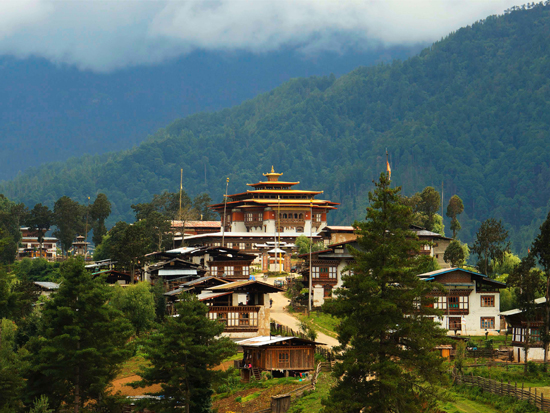
Bumthang-Gangtey (Phobjikha Valley)
Start early today for Gangtey, about 6 hrs from Bumthang. Farmhouses and temples dot the landscape and you will see local farmers wearing the traditional woven bamboo hats of central Bhutan. The wide and picturesque Phobjikha valley is one of Bhutan’s few glacial valleys, and chosen winter home of black necked cranes (November-March) migrating from the Tibetan plateau. Visit Gangtey Goempa (Monastery), the only Nyingmapa monastery in western Bhutan. Overnight at your hotel in Phobjikha.
Day 11
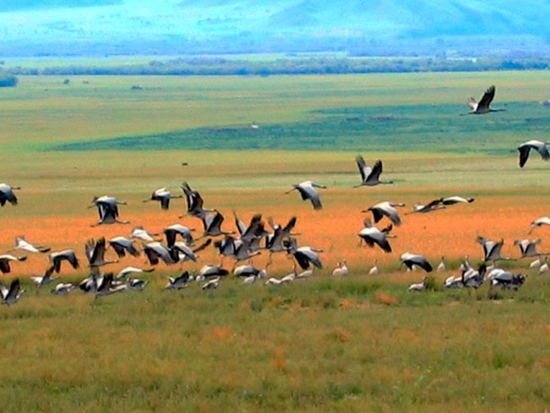
Bumthang-Gangtey (Phobjikha Valley)
Start early today for Gangtey, about 6 hrs from Bumthang. Farmhouses and temples dot the landscape and you will Morning visit to view the Black-Necked Cranes (winter only) before departing for Thimphu (approx 6 hrs). From Gangtey the road gradually descends into the balmy Punakha valley before climbing up over Dochu La Pass and into Thimphu. Remainder of day at leisure. Overnight at your hotel in Thimphu.
Day 12
Thimphu-Paro
After breakfast enjoy a morning hike to Tango Monastery (approx. 1 hr walk). Tango Monastery is a higher education institute for Buddhist monks built there in the 15th century by Drukpa Kunley (The Divine Madman). Like many Bhutanese monasteries, Tango was built over a cave where meditation and miracles were said to take place. The monastery has no less than twelve corners and, it is said, was built in only two months including the six temples within. On a clear day, the views of the surrounding valley and hills is amazing.
In the afternoon continue sightseeing in Thimphu. Visit the School for Arts and Crafts, The National Library housing the collection of Bhutanese scriptures dating back to the 8th century, the Traditional Paper Factory and a fascinating replica of a medieval farmhouse at the Folk Heritage Museum. Afterwards transfer to Paro for overnight.
Day 13
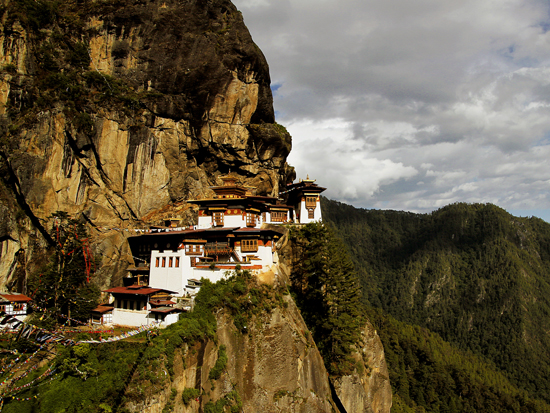
Paro
After breakfast hike to Taktsang Monastery. The walk of approximately 1.5 to 2 hours uphill takes you almost a kilometre above the Paro valley floor (for those who cannot hike we will arrange a horse for transfer up to cafeteria). The view of Taktsang Monastery built on a sheer cliff face 900 metres above the valley floor is a spectacular sight. The Monastery is also an important pilgrim site for the Buddhists. The great Guru Rimpoche is said to have flown here on the back of a tigress when he brought the teachings of the Buddhist Dharma to Bhutan in the 8th Century. Nearby there is a teahouse where you can stop for refreshments before returning to Paro for lunch.
In the afternoon drive to the ruins of the 17th Century Drukgyel Dzong, built to commemorate a victory against invading Tibetans in 1644. In fine weather the towering peak of the sacred Mount Jomolhari (7314m) appears as a stunning backdrop. On the return drive to Paro, visit 7th Century Kyichu Lhakhang, one of the 108 temples constructed by the Tibetan king Songtsen Gampo.
Alternatively, day 13 could be spent on a day trip to the Haa Valley, one of the most picturesque districts in Bhutan. Reached via the beautiful Chelila Pass, Haa Valley is characterised by its surrounding rugged and mountainous terrain. Overnight at your hotel in Paro.
Day 14
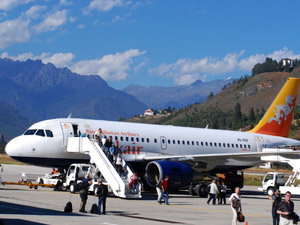
Depart Paro
Breakfast in the hotel, then drive to the airport for flight to your onward destination.
Tashi Delek!





